Albies On The Fly
Want to catch an albie on the fly? Sidestep some common errors by taking advice from anglers further along the learning curve.
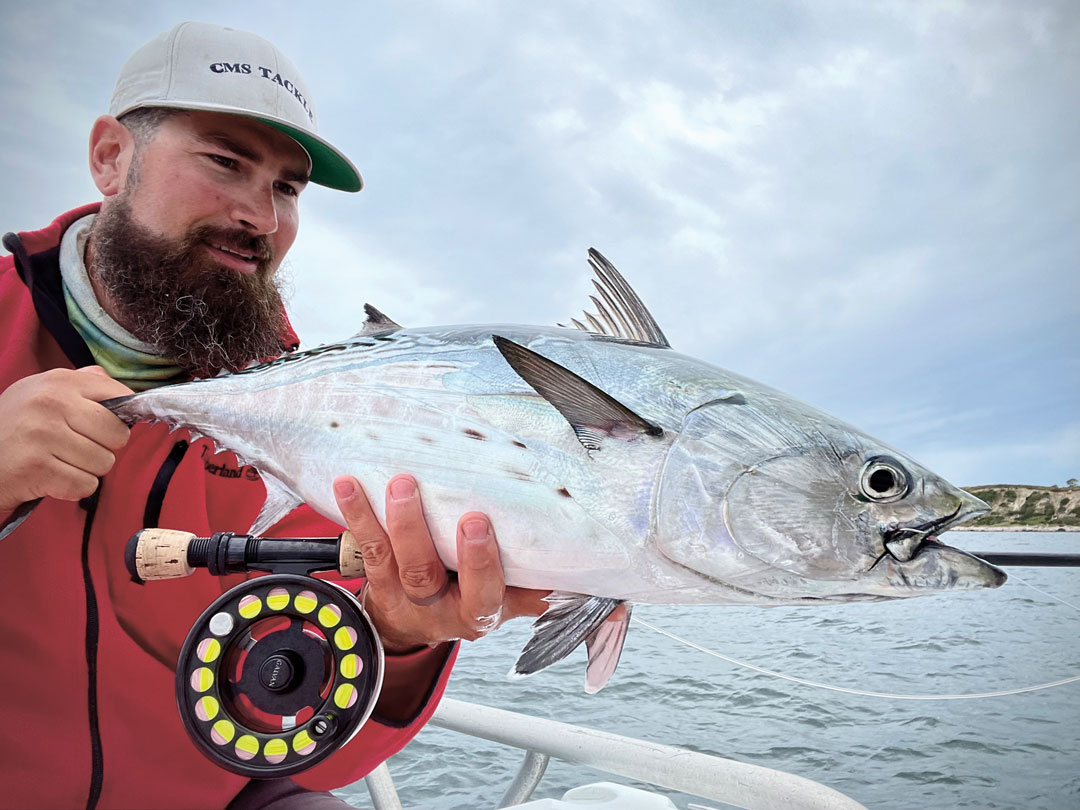
Things happen fast in albie fishing.
But, somehow, it’s the opposite of a blur. Like video captured in frames per second, when I played it back in my mind, every split second stands out like a still image. In the 2.4 seconds it takes to hook and lose an albie on a fly rod, a series of instants are recorded in my mind.
Of course, it helped that I had a GoPro camera mounted over my shoulder that was actually capturing 60 frames per second to reinforce my memory when I played it back. The sudden, audible slashes ripping into the surface 15 yards off the bow of my kayak; the rushed but adequate cast that plunked a white Clouser Minnow just ahead of a splash; the first strip that turned into a strip-strike; and the way the coils of fly line came to life like a panicked snake, throwing a loop around my left kayak pedal that tightened into an instant chokehold.
Pop.
It was a heartbreaking moment, but it was also progress since it was the first time I’d convinced an albie to eat a fly. I’d taken my fly rod albie fishing in previous seasons, but I’d never been serious about putting down my spinning rod and picking it up. This was the first year I had made it my mission; I’d sworn over the winter fly-tying table that it was my one goal for the upcoming season.
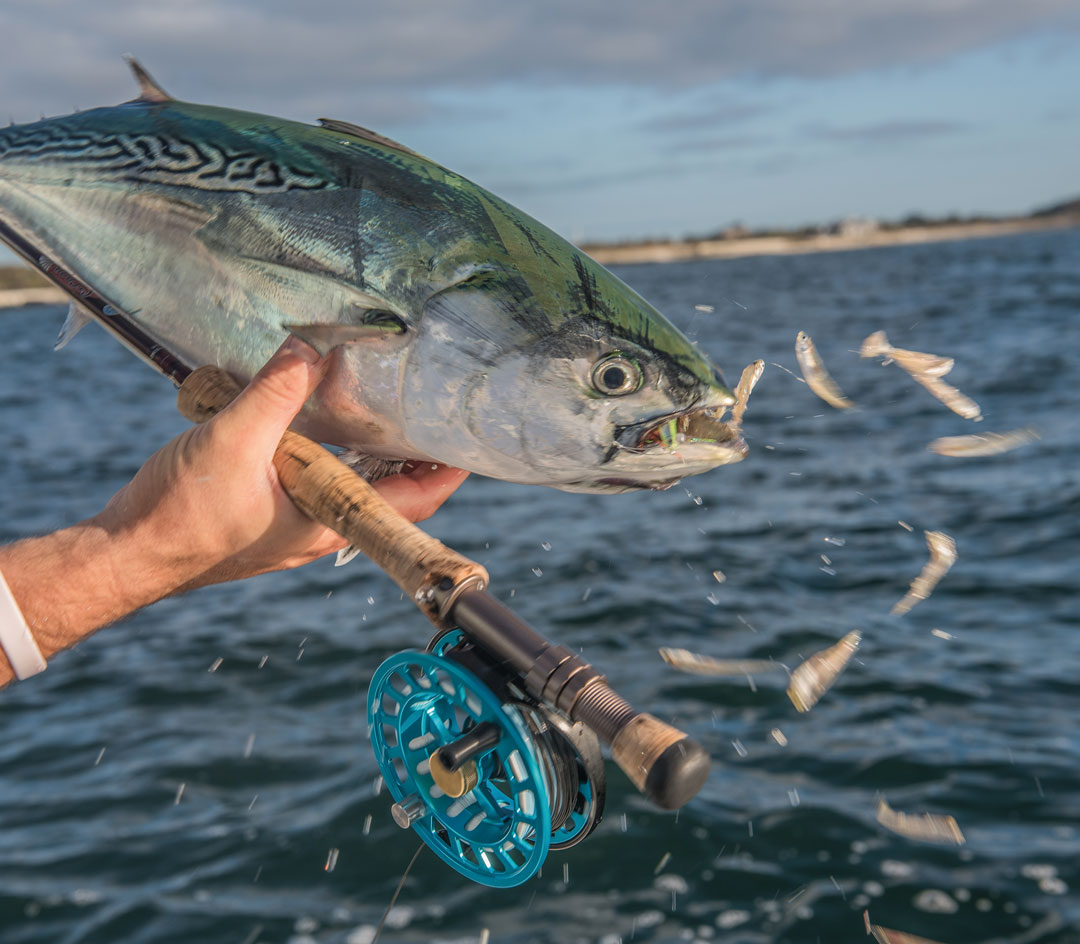
The first lesson I learned was that if I wanted to catch an albie on a fly rod, I had to leave the spinning rod at home. Too many times I’d missed perfect opportunities because I couldn’t resist picking up the spinning outfit for the extra reach and confidence it gave me.
The second lesson was that hooking an albie was only one part of the challenge. Clearing the line and getting the fish onto the reel was the next step.
The next time I hooked an albie on a fly rod, I was able to skip the part where I froze in awe and instead immediately made sure to guide the fly line out of the kayak without snagging it on the pedals. It helped that the fish hit coming toward me and continued in that direction so the line snaked out through the guides at a controlled pace as the fish pulled against the resistance of the arc of fly line ripping through the water. I lifted the rod above my head and pointed it back at a 45-degree angle to the water as the albie streaked behind my right shoulder and the line came tight on the reel, anticipating the sweet sound of my drag screaming.
What I didn’t realize is that the fly line had thrown a loop back around the outside of the reel. The force of the albie swimming at full speed suddenly coming tight jerked my hand back and sprained my right thumb so badly that I eventually needed to see a physical therapist.
Pop.
Another lesson learned.
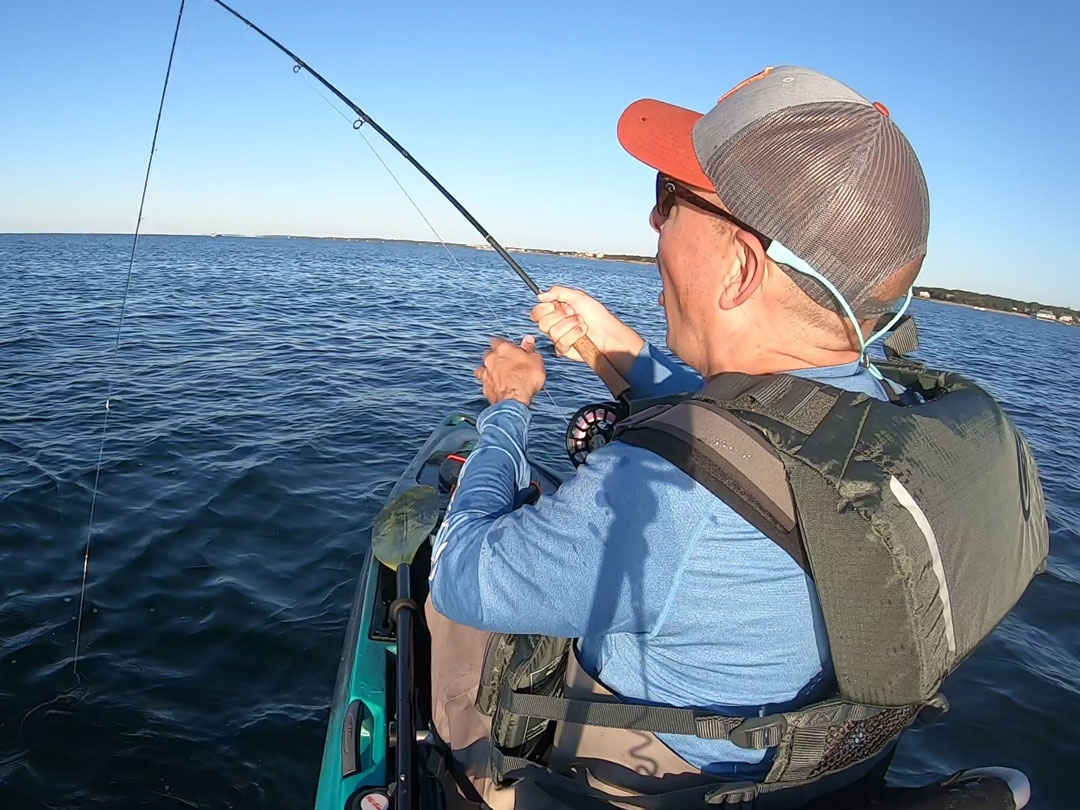
The third time I hooked an albie on the fly was one of those mornings when everything was clicking. The wind was light, the late-summer air was crisp and dry, and the sky was just starting to show orange as I pedaled across open water toward the inlet. I already had a small amount of line stripped and waiting at my feet when I saw the first splash ahead of me and quickened my pace, then glided to a stop and waited to see if the fish popped up again. Another slash, another adequate cast with a white Clouser, and a simultaneous strike as a fish met the touchdown of the fly with an open mouth and instantly hooked itself.
This time, the line cleared, came tight, and the drag sang. For the next few minutes, I alternately reeled like a madman as the fish ran toward me and had my knuckles rapped by the reel handle as the fish streaked away. I had an is-this-really-happening/kid-on-a-rollercoaster grin on my face the whole time. When I saw the leader, I was already picturing the photo I’d take, the text to my coworkers, and the Instagram post (and the fire emojis it would garner). All I needed to do was land it.
Landing any fish from a kayak on a long, whippy fly rod is a challenge. Landing a frantic false albacore when you’re too excited to remember that fly rods aren’t meant to bend into a horseshoe shape?
POW.
Another lesson learned: Don’t high-stick an albie next to the kayak.
However, that lesson might be harder to keep in mind because it didn’t have the same repercussion as the first two. Yes, I paid the price of an Orvis Clearwater flyrod, but I got my fish, my photos, and my sweet emoji feedback.
I’m determined to find more success this season as I make my way along the albie-on-the-fly learning curve. But, rather than let the fish teach me all the lessons through trial and error, I decided to reach out to a couple of pros and let them share some expertise.
I checked in with two fishermen and regular On The Water columnists who have years of experience catching albies and other “funny fish” on flies, Captain Casey Allen of New Bedford, Massachusetts, and Captain Dave Peros of Cape Cod.
Albie Setup
For albie fishing, I use the same 9-foot, 9-weight Orvis Clearwater rod I use as my all-around striper-fishing setup. It’s lined with Rio Coastal Quickshooter XP, an aggressive-taper, full intermediate line. Should I have an albie-specific setup?
“With the smaller albies we see inshore, a nine-weight is fine,” said Peros. “What’s most important is that it has some lifting power in the butt section to finish the fight when an albie is spiraling next to the boat.”
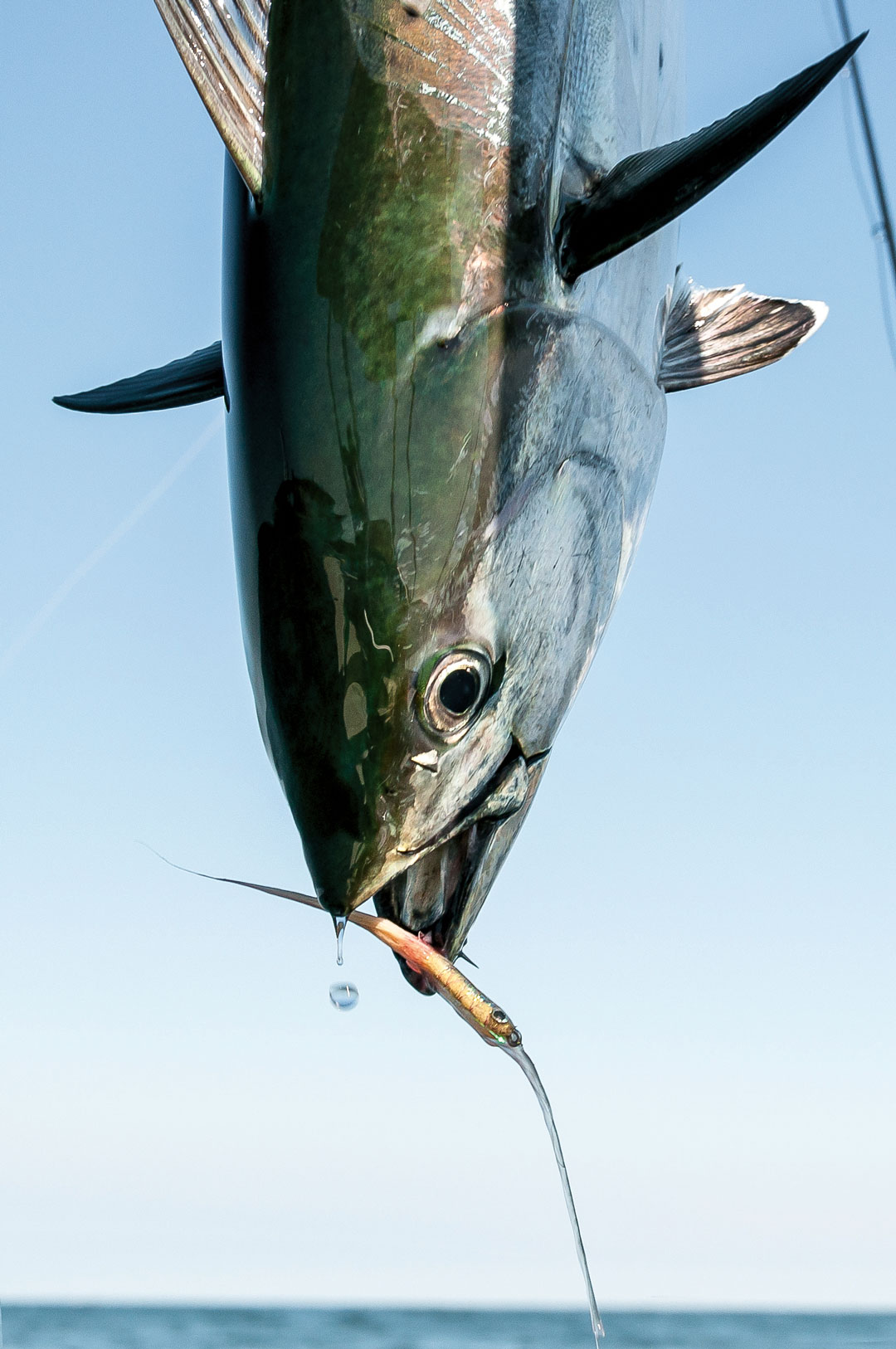
Allen agreed with the importance of reducing fight time, and that’s one reason he primarily fishes with a 10-weight when chasing albies. The other reason is for the extra casting power in windy conditions, which are the norm in the Northeast in the fall.
Allen also fishes the Coastal Quickshooter XP by Rio, though he occasionally uses a full-sink line when weeds on the surface present a persistent fouling issue.
Peros said that many of his clients prefer a full-sink line for ease of casting—it loads fast, requiring fewer false casts, and tends to result in a straight-line connection when the fly lands on the water. However, he likes to argue in favor of a floating line when fishing for blitzing false albacore because it allows an angler to easily pick a fly up and put it back in a different place without having to strip it to the boat. For fast-moving fish like false albacore, this is often the best way to put a presentation in front of them.
“I’m always asking my anglers to pick it up and put it back, pick it up and put it back. A floating line allows them to re-present the fly to the fish.”
When it comes to leaders, Allen makes his own, usually joining a 3-foot butt section of 40-pound mono to a 4-foot section of 20-pound mono for the tippet. If conditions are calm and bright, he uses 2 feet of 20-pound and a 3-foot section of 15-pound fluorocarbon after the butt section.
Peros also recommended tying your own leaders and emphasized the importance of a stiff butt section, at least 40-pound test, for a smoother taper off the fly line and easier turnover of the fly.
False Albacore Flies
I’ve fished with small white Clousers when targeting albies because I can tie them myself and I like that they immediately sink below the surface film when they splash down.
Allen ties hundreds of albie flies and sells them through his Instagram page (@captaincasey09). His favorite pattern for albies in the Northeast is the Albie Whore, a pattern developed by Rich Reagan of Long Island.
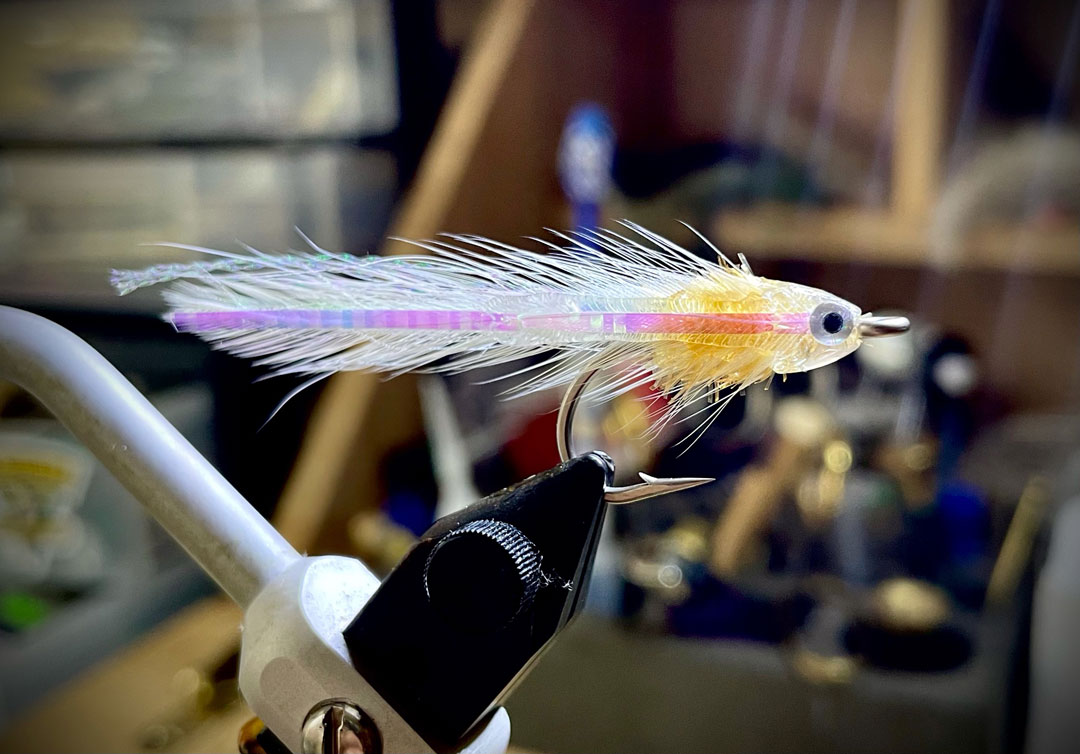
“I began ‘tying’ this fly several years ago after finding success with one a friend gave me,” said Allen. “I put tying in quotes because the fly is constructed more than tied. Using hot glue, materials are welded together for a durable, realistic baitfish imitation. I tie them in a variety of sizes, but my favorite is just under 2.5 inches and is especially effective when albies are focused on tiny bay anchovies, peanut bunker, or silversides.”
Allen also keeps Surf Candies, Clouser Minnows, and Bonito Bunnies on hand. Offering a fly similar in size to the bait is often the key to success, so he carries a range of sizes. Color can also be important, so he ties patterns in white, chartreuse, pink, and natural color schemes.
Peros recommended a number of patterns including the Bonito Bunny, Bonito Bandit, Albie Whore, Mushmouth, Boylermaker Albie Fly, Mikkelson’s Skeeter, Crease Fly, and Gummy Minnow.
“There are plenty of good fly patterns out there, but for me the key to effective funny-fish fly-rodding is good, clean casting, line control, and fly presentation,” said Peros.
We’ll get to that next.
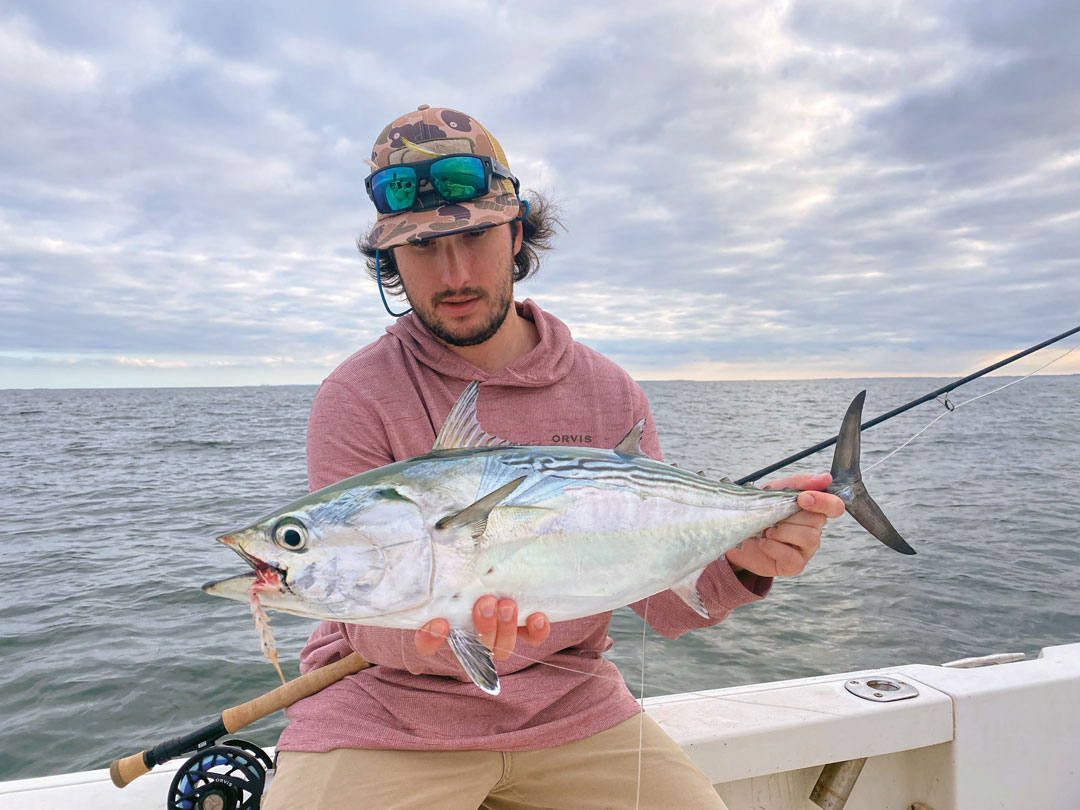
Casting
The biggest benefit I’ve found from kayak fishing for albies is that I can get very close to the fish, negating the need for long, accurate casts. Often, it’s a short flip or roll of the line to get a fly into fish rather than a full cast. From a boat, that’s not usually the case.
That doesn’t mean distance casting is necessary. According to Peros, an angler is better served working on accuracy at distances of 50 to 60 feet with minimal false casting and making a cast that gets the fly moving immediately after it hits the water.
“The biggest mistake I see from my clients is that they are in too much of a hurry,” said Peros. “They get excited, rush their casts, make too many false casts, and when they eventually drop the line, it doesn’t land straight.
It’s understandable. Albies will blow your mind and seeing them on the surface can make you lose your cool. I’ve actually told clients to stop casting, sit down, take a breath, and relax. All I need is one good cast, and I’d rather get that one cast than ten lousy ones.
“Practice, practice, and then practice your casting some more. Just like the best tarpon fly-rodders, who seem so nonchalant and appear to have nerves of steel, the best albie and bonito fly anglers got that way because of experience and trial and error.”
Retrieve
Based on years of burning epoxy jigs along the surface on spinning gear, my inclination is to get the fly moving and moving fast. However, one of the reasons fly fishing is effective is that there are more retrieve options than just “fast.” It’s a hot topic among albie fishermen, and like many other aspects of fishing, everyone has their preferred techniques.
“To me, one of the most important things is always having the fly line in my hands, which is accomplished with a hand-over-hand technique,” said Allen. “When using a single-hand retrieve, you must let go of the fly line at the end of every strip, which leaves you unable to set the hook properly should a fish hit during that brief moment. With a hand-over-hand retrieve, you’re ready to deliver a solid strip-set at all times, and you can pick up line if a fish takes the fly and swims at you.”
Although most people associate the hand-over-hand retrieve with speed, Allen uses it whether he’s burning the fly back to the boat, inching it along, or dead-drifting it.
“Whether blind-casting or sending the fly into a raging surface feed, retrieve speed is something that often requires experimenting. A fast retrieve is frequently effective, but sometimes a slower retrieve studded with long pauses does the job; other times, a dead drift seals the deal. Overall, my most consistent technique when casting to feeding fish is to steadily retrieve the fly for several feet, then abruptly stop and let the fly sink.”
Line Management
“One of the most important aspects of successfully landing a false albacore on the fly is line management, especially after a fish is hooked and the line begins shooting through your fingers,” said Allen.
That was one lesson I’d already learned the hard way.
“If there’s an object the line could potentially get tangled on, you can almost be certain it will,” said Allen. “If a cleat can’t be avoided, covering it with a wet towel is an effective trick.”
Peros also spoke on the importance of line management and said that it starts with the cast.
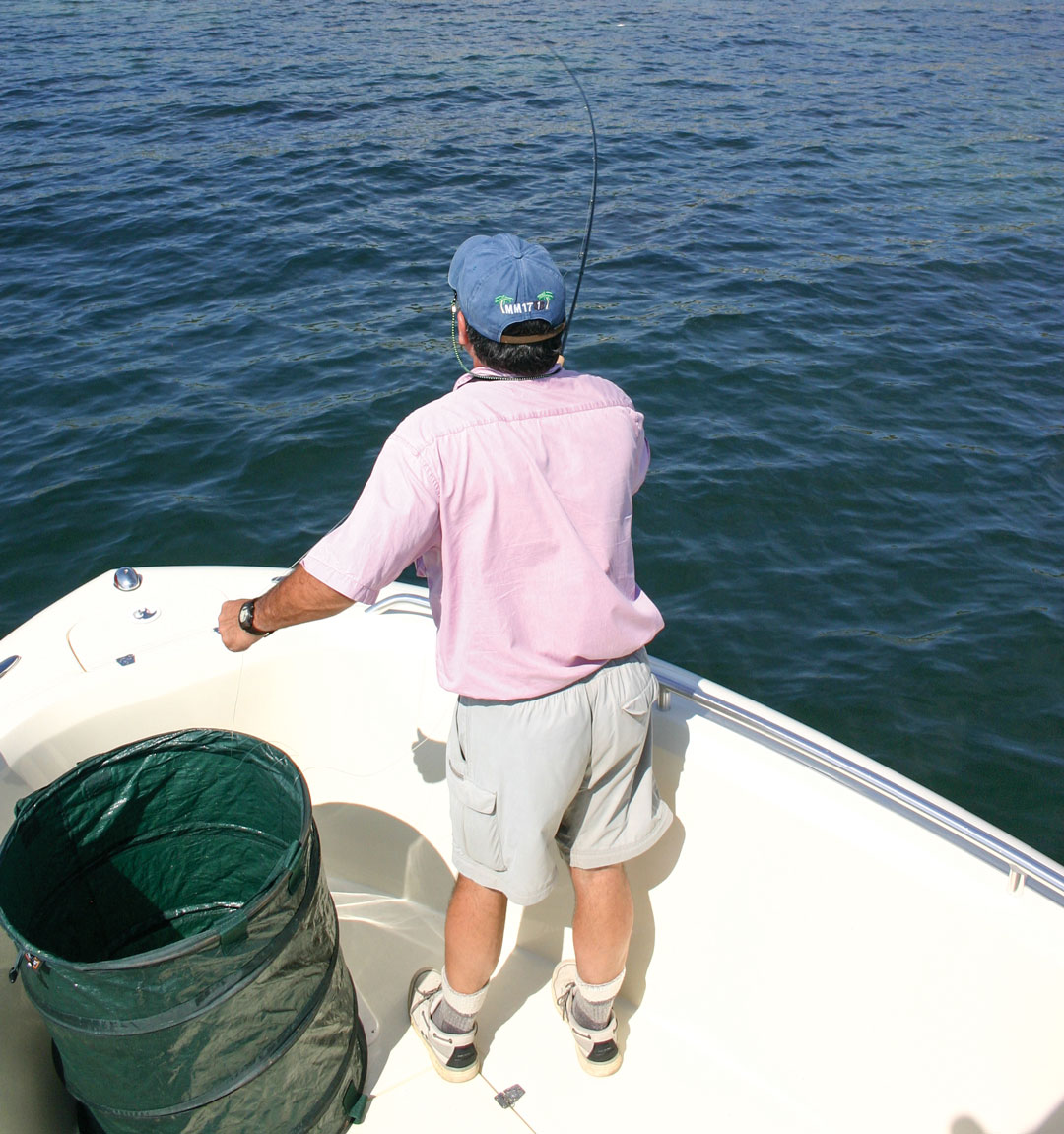
“Don’t make a hero cast and let go of the fly line when casting,” said Peros. “Form an ‘O’ with your line thumb and forefinger when casting, allowing the line to flow freely. This gives you an opportunity to direct it from the rod butt, reel handle, or other line-grabber and puts you in a position to strip line immediately.”
Peros also called a stripping bucket an essential piece of equipment when fly fishing from a boat.
“And I’m not talking about one of those plastic ones that shore folks use. I use a large, collapsible lawn-and-leaf bucket, complete with a fly-line management mat on the bottom to weigh it down.”
Unfortunately, a 30-gallon lawn barrel isn’t practical on a kayak. I have some ideas that I might try (and that might work), including a custom floor mat, a mini foam stripping basket, and a lap blanket. I’ve even considered that a pair of drop-crotch joggers would form a type of between-the-knees line receptacle, but they remain in my Amazon shopping cart for now. I’m fully prepared for another season of learning by trial and error, but I’d welcome advice from any angler who’s been there. Email me at kevin@onthewater.com.
1 thought on “Albies On The Fly”
-
charles soumas Would On The Water be interested in a story about an unsolved murder that took place in a mansion 200 yards from a jetty in Cotuit written by someone who was one of four fishermen fishing on the jetty
Leave a Reply